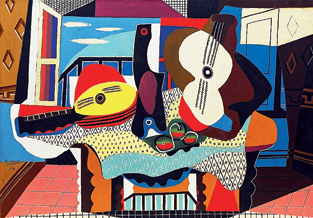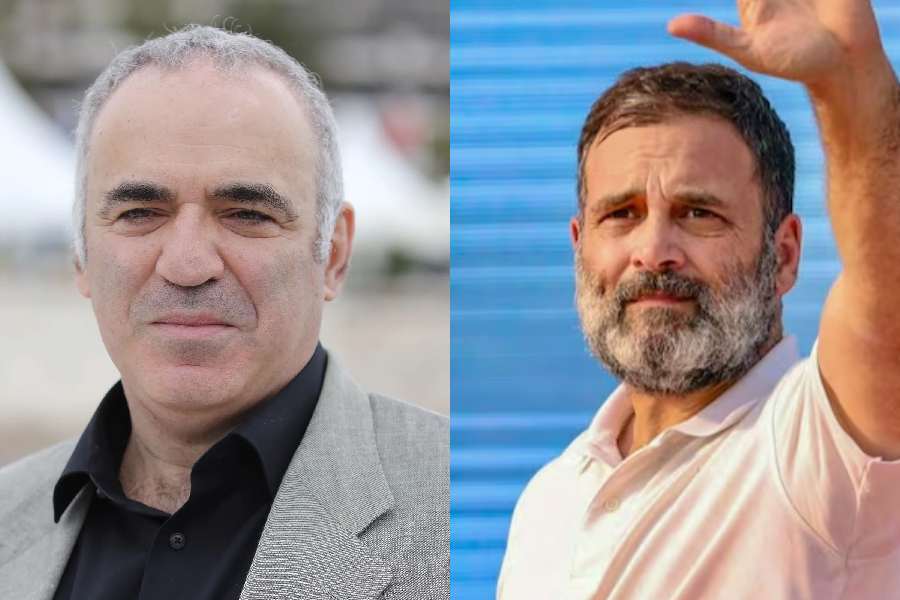One was a firefighter and the other traded in his electric guitar for a classical one. Carlo Aonzo (mandolin) and Lorenzo Bernardi (guitar) were in Calcutta in February to perform their project, ‘Journey Through Italy’, at Victoria Memorial Hall. The idea was to take the audience on an imaginary voyage through Italy with their interpretation of different scores. The two met during a guitar festival in June 2019 and have performed their project in the US and Panama as well. The Telegraph caught up with the duo.
Lorenzo, you have come to Calcutta before for the Calcutta International Classical Guitar Festival. What do you think of the talent here?
Lorenzo Bernardi: The classical guitar scene is growing superfast in India. Today, I had a chance to meet a student to give him a lesson and I can see the improvements the guitar festival is making. Even David Russell came last year. The interest is growing really fast.
Carlo, this is your first time in India. What have you heard of the scene here?
Carlo Aonzo: Recently I learnt that Mother Teresa knew how to play the mandolin. I also had the chance to meet many mandolin players with different techniques. We met an ensemble of mandolin-playing girls — all 13- and 14-year-olds — in Bangalore. So there is interest in the mandolin.

Pablo Picasso’s Mandolin and Guitar (1924) resides at the Guggenheim Museum in New York Sourced by the Telegraph
What do the two of you like about each other’s sound?
Lorenzo: We met at a guitar festival in Vietnam in June 2019. And I didn’t know the mandolin at all, so I was fascinated by his performance with an American guitarist. I was so fascinated that I proposed a collaboration. That’s how it started and then we played in the States and Panama. He has been in concerts around the world all his life. I’m still young and learning how to do that. He is the master and I help him my way.
Carlo: Lorenzo is a great classical guitar player; he also knows how to organise tours. If you want to talk about sound… the mandolin and the guitar make for a great combination. You will see both the instruments in many paintings. Both are plucked instruments. I pluck with a plectrum and Lorenzo plucks with his nails. The range of the guitar is lower, for the mandolin it is higher, which also helps the sound. It is an interesting and expressive sound.
How does a difference in range help with the overall sound balance?
Carlo: There’s a technique in which you pluck one note and it fades away while another technique helps to sustain the note. With these techniques Lorenzo can accompany a range of rhythms with long notes. A lot of research has gone into the musicality part, so as to express a range of emotions.
How would you describe your individual tones?
Lorenzo: I’m focused on lyrical sounds… the sound a singer would make with his or her voice. I always try to achieve a sound that’s round, so I place my nails in a very specific way and I’ve studied a lot about how to dig into the sound with my right hand and how to master the movement that will get me that lyrical sound while complementing the mandolin. The sound is less treble and more lyrical.
What is the biggest challenge when it comes to classical music?
Carlo: It depends. First, there is the issue of approach. I was trained as a classical musician and the first thing one learns is to read music. So the approach involves notation sheets and theories around melody, rhythm… the challenge is to get there but then you realise that you also have to play without sheets and have a direct approach. When you can play by ear, the next challenge is to play classical music. In terms of musicality, classical music is a combination of different styles. It is important to know the composer, the occasion for which he wrote a particular piece and what he wanted to express.
Lorenzo: The biggest challenge for me is interpretation. It is important to respect the composer and his ideas, so you don’t want to do something extravagant that would change the original idea. Music is art. If you read Shakespeare you have to know the characters, the writer and interpret them in the best way possible; it’s the same with music. So we have to research and respect the composer.
What does improvisation mean to you?
Carlo: Improvisation means freedom. But one also needs to know a lot of theory and chords to improvise.
Lorenzo: Improvisation for me is something difficult. It’s something I’m trying to explore because in my training as a classical guitar player I didn’t have a chance to research a lot about this aspect.
On the stage, how do you ensure that the two of you are in sync?
Carlo: Practice, practice, practice. You have to prepare well to lend it a high level of musicality. It is a lot of work to be on the same page when it comes to mood, idea and direction.
Many musicians tell stories and express emotions while playing….
Carlo: Yes, absolutely. You have to bring people to your world and make them feel. The climax can be dramatic or intimate, you have to put it together.
Lorenzo: People also interpret what they hear. Someone might hear a melodic sound and remember something happy. Music can arouse certain memories, that’s the power of music.
What are some basic things to keep in mind while learning classical music?
Lorenzo: The most important thing is to attract attention. Everyone is different and you need to understand your student and find the best method for him or her. That’s the difficult part of being a teacher.
Carlo: When you’re teaching you become a reference point for somebody. It is important to help students explore sounds that can become an extension of the body.
Carlo, you were a firefighter, and Lorenzo, you were a part of a rock band in which you played the electric guitar. So classical music…
Lorenzo: My band’s name was Panic Room (laughs).
Carlo: I’ve been a mandolin player since childhood. Then my father taught me classical music. Professionally, I was a firefighter for 25 years but my music career was growing at the same time. Three years ago I decided to quit firefighting.
Lorenzo: I had just started secondary school… you know, the time when you pick up an instrument as a hobby. So the electric guitar was all that I was seeing on TV; I didn’t even know the existence of classical guitar. My teacher was actually a classical guitar player. Once I heard the sound of the beautiful nylon strings, I was attracted by it.










